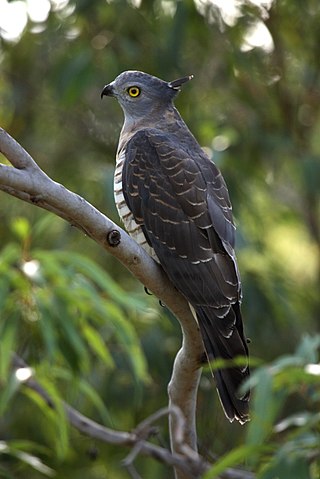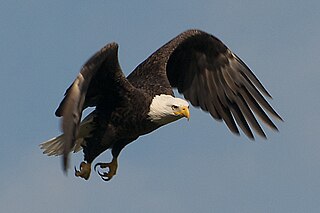
Eagle is the common name for the golden eagle, bald eagle, and other birds of prey in the family Accipitridae. Eagles belong to several groups of genera, some of which are closely related. True eagles comprise the genus Aquila. Most of the 68 species of eagles are from Eurasia and Africa. Outside this area, just 14 species can be found—two in North America, nine in Central and South America, and three in Australia.

Birds of prey or predatory birds, also known as raptors, are hypercarnivorous bird species that actively hunt and feed on other vertebrates. In addition to speed and strength, these predators have keen eyesight for detecting prey from a distance or during flight, strong feet with sharp talons for grasping or killing prey, and powerful, curved beaks for tearing off flesh. Although predatory birds primarily hunt live prey, many species also scavenge and eat carrion.

The Accipitridae is one of the three families within the order Accipitriformes, and is a family of small to large birds of prey with strongly hooked bills and variable morphology based on diet. They feed on a range of prey items from insects to medium-sized mammals, with a number feeding on carrion and a few feeding on fruit. The Accipitridae have a cosmopolitan distribution, being found on all the world's continents and a number of oceanic island groups. Some species are migratory. The family contains 255 species which are divided into 70 genera.

The Accipitriformes are an order of birds that includes most of the diurnal birds of prey, including hawks, eagles, vultures, and kites, but not falcons.

Aegypiinae is one of two subfamilies of Accipitridae that are referred to as Old World vultures, the other being the Gypaetinae. They are not closely related to the Gypaetinae, and are instead a sister group to the serpent-eagles (Circaetinae).

The Buteoninae are a subfamily of birds of prey which consists of medium to large, broad-winged species.

The raptor subfamily Perninae includes a number of medium-sized broad-winged species. These are birds of warmer climates, although the Pernis species have a more extensive range.

An elanine kite is any of several small, lightly-built raptors with long, pointed wings.

Wahlberg's eagle is a bird of prey that is native to sub-Saharan Africa, where it is a seasonal migrant in the woodlands and savannas. It is named after the Swedish naturalist Johan August Wahlberg. Like all eagles, it belongs to the family Accipitridae.

The grey-headed fish eagle is a fish-eating bird of prey from South East Asia. It is a large stocky raptor with adults having dark brown upper body, grey head and lighter underbelly and white legs. Juveniles are paler with darker streaking. It is often confused with the lesser fish eagle and the Pallas's fish eagle. The lesser fish eagle is similar in plumage but smaller and the Pallas's fish eagle shares the same habitat and feeding behaviour but is larger with longer wings and darker underparts. Is often called tank eagle in Sri Lanka due to its fondness for irrigation tanks.

A sea eagle or fish eagle is any of the birds of prey in the subfamily Haliaeetinae of the bird of prey family Accipitridae. Ten extant species exist, currently described with this label.

The solitary eagle or montane solitary eagle is a large Neotropical eagle. It is also known as the black solitary eagle.

The genus Hieraaetus, sometimes known as small eagles or hawk-eagles, denotes a group of smallish eagles usually placed in the accipitrid subfamilies Buteoninae or Aquilinae.

Cassin's hawk-eagle or Cassin's eagle, is a relatively small eagle in the family Accipitridae. Its feathered legs mark it as member of the Aquilinae or booted eagle subfamily. A forest-dependent species, it occurs in primary rainforests across western, central and (marginally) eastern Africa where it preys on birds and tree squirrels. It was named after John Cassin who first described it in 1865. Due to widespread habitat destruction, its populations are steadily declining but have not yet warranted upgrading its status from Least Concern.

Falconinae is a subfamily of falconid birds of prey that includes 44 species in three genera. It includes Microhierax, Polihierax, and Falco. Molecular data since 2015 has found support in the grouping of these genera, with Polihierax being paraphyletic in respect to Falco. Falconinae and their sister taxon, Polyborinae, split off from Herpetotherinae around 30.2 million years ago in the Oligocene epoch. Falconines split off from the polyborines around 20 million years ago in the Miocene epoch.

The Gypaetinae is one of two subfamilies of Old World vultures the other being the Aegypiinae. Some taxonomic authorities place the Gypaetinae within the Perninae hawks. They are presently found throughout much of Africa, Asia, and southern Europe, hence being considered "Old World" vultures, but as recently as the Late Pleistocene, they were also present in North America.

The Aquilinae are a subfamily of eagles of the family Accipitridae. The general common name used for members of this subfamily is "booted eagle", although this is also the common name of a member of the subfamily. At one point, this subfamily was considered inclusive with the Buteoninae based probably on some shared morphological characteristics. However, research on the DNA of the booted eagles has shown that they are a monophyletic group that probably have had millions of years of separation from other extant forms of accipitrid.

The Harpiinae is a bird of prey subfamily which consists of large broad-winged species native to tropical forests. There are 4 genera in the subfamily, all monotypic.
Booted eagles are eagles that have fully feathered tarsi. That is, their legs are covered with feathers down to the feet. Most other accipitrids have bare lower legs, scaled rather than feathered.

David P. Mindell is an American evolutionary biologist and author. He is currently a senior researcher at the University of California, Berkeley, Museum of Vertebrate Zoology. Mindell's work is focused on the systematics, conservation and molecular evolution of birds, especially birds of prey. He is known for his 2006 book, The Evolving World in which he explained, for the general public, how evolution applies to everyday life.

























